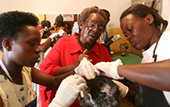What is Obstetric Fistula (VVF)?
Obstetric (or Vesico-Vaginal fistula –VVF) is a devastating condition that affects poor rural women and girls across the continent. It manifests itself as an abnormal communication between the urinary bladder and vagina, which leads to uncontrolled, continuous leakage of urine and/or fecal matter (for RVF cases).
The World Health Organization has called fistula “the single most dramatic aftermath of neglected childbirth” estimating that more that 2 million women live with fistula worldwide.
Major causes of fistula
- Complications resulting from obstructed labor.
- Sexual violence.
- Lack of access to maternity care (skilled care and availability of facilities).
- Early marriage and childbirth.
- Harmful traditional practices like female genital mutilation (FGM).
- Poverty – malnutrition thus stunted growth.
What happens to women with fistula?
Many women with VVF are ostracized and disowned by their families and communities. Most of them hide away in shame and isolation, literally waiting for death to come knocking.
How can obstetric fistula be prevented?
- Delaying the age of first pregnancy
- The cessation of harmful traditional practices
- Timely access to obstetric care
Fast Facts about Fistula in Kenya
In Kenya, it is estimated that fistula occurrence stands at 3 to 4 women for every 1,000 deliveries
- There are an estimated 3,000 new cases of fistula each year in Kenya, with only 7.5% able to access medical care for the condition
- A UNFPA report released in 2004 estimates the backlog of fistula cases to be as high as 300,000
- For every woman who dies from pregnancy-related complications, 20 women survive but experience terrible injuries and disabilities
- One woman dies from pregnancy-related complications every minute worldwide. 95% of them live in Africa and Asia.
What are the Interventions Being Undertaken by Partners to Help Remedy the Situation?
- Kenyatta National Hospital (KNH) carries out over 200 fistula operations every year.
- The Flying Doctor’s Society of Africa (FDSA) has so far financed over 1,000 fistula operations since year 2008 at a cost of over Kshs 30m. Over 50% of these surgeries have been done at KNH.
- FDSA has partnered with KNH to carry out 100 fistula operations this year at a cost of Kshs 3m.
- FDSA has launched a National Fistula campaign with over 5 camps planned this year to restore dignity to over 250 women. The first camp is starting on 22nd March 2014 at Guru Nanak Hospital
What More Needs to be Done?
- There needs to be more training for doctors who can perform fistula surgeries. Currently, there are only about 10 fistula surgeons in the country.
- There is a need to subsidize the costs for fistula surgery in provincial and district hospitals in order to make this treatment affordable to more Kenyans.
- Besides training in fistula repair, it is very important to train health care providers particularly Doctors, Midwifes and Nurses on secondary prevention emphasizing the key areas health providers need to pay attention to in cases of obstructed labor. These include:
- Fixing a catheter and leaving it in for 4-6 weeks
- Advice mother to drink five or more litres of water per day
- Advice on the use of sitz baths immediately after delivery
- Performance of a speculum examination within the first week of birth which helps clear any debris left in the uterus.
With these four interventions, 15-20% of fistula cases can heal spontaneously. However, should a fistula develop, it can be operated within six weeks of delivery (as opposed to the usual 3 months).
- The roles of traditional birth attendants and dispensaries need to be redefined. This is a policy issue.
- The need for programmatic approaches that see the integration and visibility of obstetric fistula within Safe Motherhood Interventions.
- The need for institutional preparedness that will see an improvement in the quality of care at health facilities as well as effective referral systems.
- More awareness campaigns at the community level.
- Enhancing of more partnerships between the government and different stakeholders.














